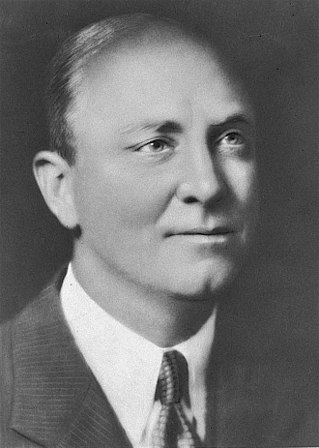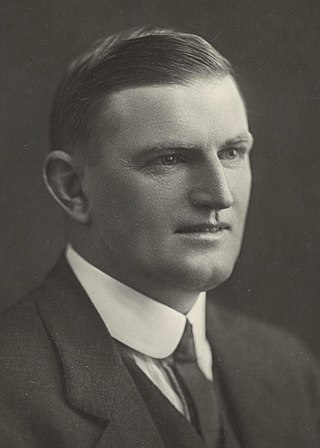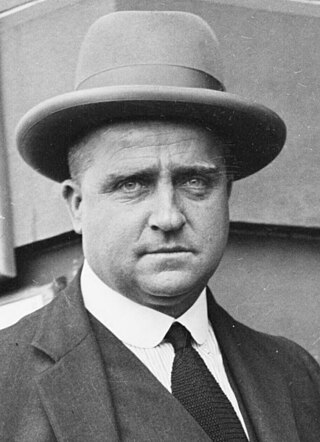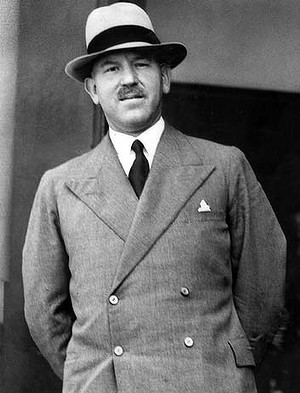
The New Guard was an Australian fascist paramilitary organisation during the Great Depression. It was the largest and most successful fascist organisation in Australian history.

Alexander Mair was an Australian politician who served as Premier of New South Wales from 5 August 1939 to 16 May 1941. Born in Melbourne, Mair worked in various businesses there before moving to Albury, New South Wales where he went on to be a member of the New South Wales Legislative Assembly for fourteen years. In 1932, Mair was elected to the seat of Albury and was re-elected a further four times. He rose quickly through the cabinet of Bertram Stevens' United Australia Party government, becoming an Assistant Minister in April 1938, Minister for Labour and Industry in June and Colonial Treasurer in October.

Reginald Walter Darcy Weaver was an Australian conservative parliamentarian who served in the New South Wales Legislative Assembly for 28 years. Serving from 1917 in the backbenches, he entered the cabinet of Thomas Bavin in 1929 as Secretary for Mines and Minister for Forests until he returned to opposition in 1930. Following the success of the United Australia Party in the 1932 election, Weaver returned as the Secretary for Public Works and Minister for Health in the Stevens ministry.

Lieutenant Colonel Sir Michael Frederick Bruxner was an Australian politician and soldier, serving for many years as leader of the Country Party in New South Wales. Born in the north of the state, Bruxner was educated at The Armidale School and started studies at University of Sydney but later dropped out to take up employment as a grazier and station agent in Tenterfield. After serving in the Citizen Military Forces from 1911, Bruxner enlisted into the Australian Light Horse upon the outbreak of the First World War in 1914. Serving with distinction in Gallipoli, Egypt and Palestine, he was promoted to lieutenant colonel and awarded the Distinguished Service Order.

Lucien Lawrence "Lou" Cunningham was an Australian farmer and politician.
Members of the New South Wales Legislative Assembly who served in the 33rd parliament held their seats from 1941 to 1944. They were elected at the 1941 state election, and at by-elections. During this term, the opposition United Australia Party merged with the new Commonwealth Party to form the Democratic Party in late 1943. The merger was only at a state level, however; the federal United Australia Party, however, remained intact during this period. The Speaker was Daniel Clyne.
Members of the New South Wales Legislative Assembly who served in the 32nd parliament held their seats from 1938 to 1941. They were elected at the 1938 state election, and at by-elections. The Speaker was Reginald Weaver.

The 1932 New South Wales state election was held on 11 June 1932. This election was for all of the 90 seats in the 30th New South Wales Legislative Assembly and it was conducted in single member constituencies with compulsory preferential voting. It was a landslide victory for the UAP/Country Party coalition of Bertram Stevens, which had a majority of 42 in the Assembly.

Sir Vernon Haddon Treatt was an Australian lawyer, soldier, Rhodes Scholar and politician. Born in Singleton, New South Wales and educated at Shore School, Treatt interrupted his studies at the University of Sydney to enlist at the outbreak of the First World War. Serving in the Royal Australian Artillery, Treatt served in France and was awarded the Military Medal. Upon returning to Australia he was awarded a Rhodes scholarship and further educated at New College, Oxford.

The 1935 New South Wales state election was held on 11 May 1935. This election was for all of the 90 seats in the 31st New South Wales Legislative Assembly and was conducted in single member constituencies with compulsory preferential voting.

The 1938 New South Wales state election was held on 26 March 1938. This election was for all of the 90 seats in the 32nd New South Wales Legislative Assembly and was conducted in single member constituencies with compulsory preferential voting.

The 1941 New South Wales state election was held on 10 May 1941. This election was for all of the 90 seats in the 33rd New South Wales Legislative Assembly and was conducted in single-member constituencies with compulsory preferential voting.
Christopher Augustus "Gus" Kelly was an Australian politician. He was a Labor Party member of the New South Wales Legislative Assembly from 1925 to 1932 and again from 1935 until his death in 1967, representing the electorate of Bathurst. He held numerous ministerial positions between 1941 and 1965 in McKell Labor Government.
Joseph Patrick Byrne was an Australian politician. He was a Labor Party member of the New South Wales Legislative Assembly from 1930 to 1932, representing the electorate of Parramatta.

The 1944 New South Wales state election was held on 27 May 1944. It was conducted in single member constituencies with compulsory preferential voting and was held on boundaries created at a 1940 redistribution. The election was for all of the 90 seats in the Legislative Assembly.
Annandale, an electoral district of the Legislative Assembly in the Australian state of New South Wales, had two incarnations, the first from 1894 to 1920, the second from 1927 to 1950.
Tamworth, an electoral district of the Legislative Assembly in the Australian state of New South Wales, has had two incarnations from 1890 until 1920 and from 1927 until the present. It initially returned two members until 1894 and has since returned a single member for all subsequent elections.

The Stevens–Bruxner ministry (1935–1938) or Second Stevens–Bruxner ministry or Second Stevens ministry was the 47th ministry of the New South Wales Government, and was led by the 25th Premier, Bertram Stevens, in a United Australia Party coalition with the Country Party, that was led by Michael Bruxner. The ministry was the second one of three occasions when the Government was led by Stevens, as Premier; and second of four occasions where Bruxner served as Deputy Premier.

Eric Campbell, was an Australian army officer and later a solicitor who was the leader of the far-right organisation, the New Guard in New South Wales.
Sydney City, an electoral district of the Legislative Assembly in the Australian state of New South Wales, had two incarnations, from 1950 until 1971 and from 1988 until 1999.















